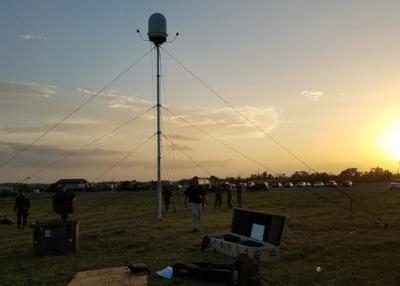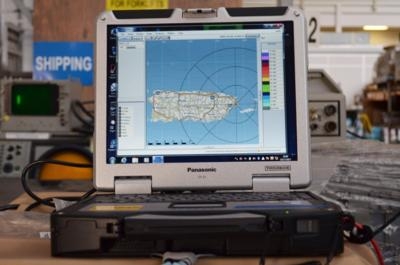Two Temporary Weather Radar Systems Deployed In Puerto Rico
Humanitarian assistance and disaster relief (HADR) missions, as well as Defense Support to Civil Authority (DSCA) efforts within the United States and its territories, require selfless volunteers, supplies, portable electricity and efficient transportation in order to reach personnel in need.

Weather radars and weather monitoring efforts are often times overlooked in the HADR and DSCA process, but are essential in order for military members and relief volunteers to complete critical tasks to save lives, safeguard equipment and protect property.
From Oct. 19-30, military and civilian technical experts from Program Executive Office Command, Control, Communications, Computers and Intelligence (PEO C4I) and Space and Naval Warfare Systems Center (SSC) Pacific deployed two portable Doppler weather radars from the Meteorological Mobile Facility (Replacement) Next Generation (METMF(R) NEXGEN) program to support weather monitoring efforts in and surrounding Puerto Rico. On Oct. 31, these radars began providing operational weather surveillance data to the U.S. National Weather Service (NWS) and Department of Defense (DoD).
Paul Anderson, and Gunnery Sgt. Erik Klueber, assigned to PEO C4I; and Vince Barton, assigned to SSC Pacific, accompanied the weather radars to Puerto Rico in order to facilitate the siting, installation and system integration with the NWS and testing of the weather radars on station.
Klueber emphasized that the testing of the weather radars in an environment like Puerto Rico provided a great training opportunity for U.S. Marines who were also in the country assisting with relief efforts.
"Six Marines from Marine Air Control Squadron II joined up with SSC Pacific, PEO C4I and the National Weather Service at Roosevelt Roads," said Klueber. "We had all worked together in the past during normal tech assists and site visits, so it was not necessarily a new relationship. The Marines were enthusiastic about helping the people of Puerto Rico recover from Hurricane Maria and wanted to ensure they did their part."
Although the Marines are proficient in the maintenance required for the weather radars and the overall gear associated with the system, Klueber explained that SSC Pacific and PEO C4I helped verify that the system was set up accurately to integrate with NWS in the unknown environment of Puerto Rico.
"Our role was to ensure the integration with the National Weather Service went smoothly because it had never been done before. Additionally, we wanted to guarantee that we accurately captured any configuration changes that needed to be made to the system at Roosevelt Roads and Aguadilla ... these are the two locations on the island where the weather radars were set up," said Klueber.

Anderson described the challenges associated with the site surveys at both locations, especially because of the damage caused by Hurricane Maria.
"Transportation to the anticipated sites proved difficult the first day in a vehicle because several side roads were flooded and there was a large amount of traffic on the main roads. Site surveys were easier once we received a little help from an MV-22 Osprey supporting the Defense Support to Civil Authority mission in country," said Anderson. "The first site survey conducted was at Roosevelt Roads. Our team tried to identify the best spot to place the radar ... everything from an air strip, to a rooftop, to even in a remote location in the woods that appeared to have greater elevation. The air strip ended up being where the first radar was set up because it had a clear view to the sky."
Anderson continued to explain that Aguadilla, the second site, turned out to be a much better location because the majority of the land was positioned on a high plateau alongside the ocean.
"Both sites provided us a real advantage in regards to radar data because they were placed on opposite coasts. Our team could see almost all the way to Haiti on the West and Anguilla on the East ... close to a 400 mile range. This is probably the most radar coverage the island has ever had at this elevation," said Anderson.
All three SSC Pacific and PEO C4I employees stressed the importance of synergy with the Marine Corps, Army, Air Force and NWS at each site.
"By all of us working together and knowing our part, we were able to set up and configure each radar in under an hour and a half," said Anderson. "I attribute this to the preparation and coordination with the National Weather Service prior to our arrival in Puerto Rico."
Barton expressed how rewarding the experience was in Puerto Rico because he was able to work alongside 'the warfighter' in a DSCA-focused environment.
"I was impressed with how the Marines, other services and the National Weather Service all came together to support a mission centered on humanitarian-related assistance," Barton. "I believe that SSC Pacific and PEO C4I validated our worth in these types of missions and set a new precedent if another disaster like Hurricane Maria ever occurs. From day one, SSC Pacific's and PEO C4I's knowledge of the weather radar systems helped translate the purpose and significance to the personnel on ground in Puerto Rico."
Information sharing, education and mentorship are three of Barton's passions, and he was grateful to share his technical expertise with military members and other weather experts onsite.
"Weather in the tropics can be completely different than what we are used to in the oceans surrounding the East and West coasts of the United States," said Barton. "This unpredictability is why operational weather radars are so critical following a natural disaster. Radars identify winds, rains and water spout formations ... all of these formations could create more challenges in disaster relief missions, so it's important to identify these hazards early."
Roberto Garcia, the meteorologist-in-charge for the Weather Forecast Office (WFO) in San Juan, Puerto Rico, made a public statement on Nov. 27 describing the impact of the two weather radars that were installed and configured by SSC Pacific and PEO C4I.
"After the deployment and installation of the two DoD radars in Puerto Rico, the impact on the NWS San Juan's operations has been enormous. The [full] integration of the DoD radars ... has aided in the preparation of all NWS San Juan's warnings, advisories and critical aviation forecast as well as daily briefings. These two radars have also helped our staff to better locate areas affected by heavy rain," said Garcia.
Rear Adm. Carl Chebi, PEO C4I commander, emphasized the combined military and civilian team made this effort noteworthy for the entire information warfare community.
"Information warfare experts, civilian and military alike, are making a difference throughout the globe," said Chebi. "This is just one example of how our technical professionals are going out into the fight, alongside warfighters, alongside first responders, and providing solutions to challenges. Our employees continue to set an impressive example in the aid and defense of our international partners and the homefront."
(Images provided with U.S. Navy news release)
 ANN's Daily Aero-Linx (04.15.24)
ANN's Daily Aero-Linx (04.15.24) Classic Aero-TV: 'No Other Options' -- The Israeli Air Force's Danny Shapira
Classic Aero-TV: 'No Other Options' -- The Israeli Air Force's Danny Shapira Aero-News: Quote of the Day (04.15.24)
Aero-News: Quote of the Day (04.15.24) Airborne 04.16.24: RV Update, Affordable Flying Expo, Diamond Lil
Airborne 04.16.24: RV Update, Affordable Flying Expo, Diamond Lil ANN's Daily Aero-Term (04.16.24): Chart Supplement US
ANN's Daily Aero-Term (04.16.24): Chart Supplement US




